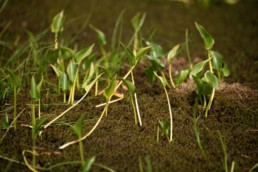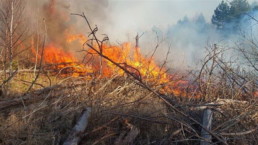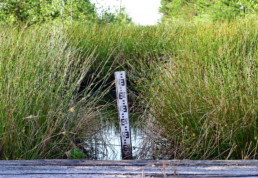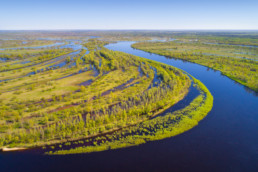Bats’ cozy home: a rare bat rediscovered in the depth of Polesia is taken under legal protection
Polesia is home to a diversity of chiropters. Scientists have reliably determined that at least twelve bat species occur here. However, the nature and peculiarities of the local habitats suggest that their number may reach up to twenty. The most important discovery was the fact that the Greater Noctule (Nyctalus lasiopterus), the largest bat in Europe, thought to be extinct from the region, can still be found in remote corners of Polesia. Thanks to the efforts of our project in the years from 2019 to 2022 , the Greater Noctule is included in the new edition of the Red Book of Belarus with the highest protection status.
The vast natural areas of Polesia are still not fully explored. Perhaps no scientist can boast of having travelled through them backward and forward. However, the region’s old-growth forests, floodplains and hardly passable bogs remain a promising field for biodiversity research, as they still serve as refuges for rare species of flora and fauna whose habitats are shrinking under the pressure of anthropogenic change.
It is interesting and important to study the bat populations in Polesia. These animals are very sensitive to changes in ecosystems, so their presence can serve as an indicator of habitat quality and importance for maintaining biodiversity. New research methods, such as passive acoustic monitoring, make it possible to quickly obtain large data sets for study. To assess the importance of the region for rare species, including bats, and to identify the areas of high conservation importance, our project carried out the first acoustic monitoring study in Polesia. Specialists installed acoustic recorders in 500 locations across the area. These devices record nocturnal forest sounds which are then sampled and classified by a special software. When it comes to bats, recording their sounds is much easier than catching these nocturnal animals in nets or using camera traps.
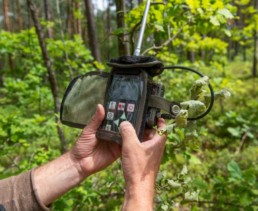

Acoustic monitoring confirmed the presence of 12 bat species in the Polesia study sites. However, this does not exclude the possibility that other species of chiropters occur there as well. One of the most important results of the study was the confirmation of the presence of the Greater Noctule in the Belarusian part of Polesia. For more than 80 years, since the last sighting in 1930, this species was considered locally extinct. Shortly before our study, two lactating females were entrapped during the bat census in a rugged old-growth forest in the Stary Zhadzien Nature Reserve. Our acoustic monitoring study provided further confirmation of the presence of this rare species in Belarusian Polesia.
These data helped us to lobby in 2021 for the inclusion of the Greater Noctule in the Red Data Book of Belarus – the list of protected species is updated every ten years, and a new edition came into force this spring. The Greater Noctule received the highest protection status. It became the 9th protected bat species in Belarus, alongside the Pond Bat (Myotis dasycneme), the Northern Bat (Eptesicus nilssonii), the Grey Long-eared Bat (Plecotus austriacus), the Common Barbastelle (Barbastella barbastellus), the Natterer’s Bat (Myotis nattereri), the Lesser Noctule (Nyctalus leisleri), the Brandt’s Bat (Myotis brandti), and the Whiskered Bat (Myotis mystacinus).
According to national regulations, bat conservation measures in Belarus include the protection of permanent colonial hibernacula (hibernation places) and breeding settlements of these animals – trees, separate buildings, cellars or semi cellars, and old fortifications. Special protection rules in bat habitats include restrictions on the use of chemical pesticides, on economic activities that disturb bats during the hibernation period, as well as felling, removal, destruction, and damage to trees that host maternal colonies of bats, as well as some other measures.
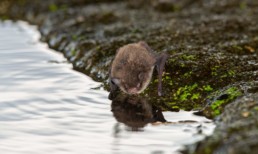
The Greater Noctule is an indicator species for the natural state of the old-growth forests. The reason of the population’s decline in Europe is the shortage of suitable habitat – old-growth forests with a great number of old hollowed trees in a small area that ensure the successful functioning of a bat colony. Most often, the Greater Noctule chooses dead trees as habitats. Thus, deadwood preservation is crucial for the conservation of this endangered species, just like for a number of others.
Unfortunately, despite expert recognition of the important role old and dead trees play in ecosystems, these trees are still often felled. Only through an elevated status of protection of the natural area at the national and international level – with the conservation measures aimed not only at an individual species, but also at the ecosystem as a whole – we can ensure the survival of many rare and sensitive species, including bats.
Safe and intact: protecting rare and typical habitats in Polesia
19. September 2025
0 Comments7 Minutes


